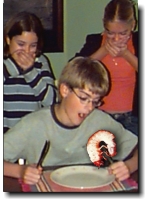
|
||||||||||||||||||||||||||
Objective (March 2015)To compare the germination rate of tomato seeds and the vigour of the growth of tomato plants, after seed exposure to the following environmental conditions:
|
||||||||||||||||||||||||||

|
||||||||||||||||||||||||||
Objective (March 2015)To compare the germination rate of tomato seeds and the vigour of the growth of tomato plants, after seed exposure to the following environmental conditions:
|
||||||||||||||||||||||||||
Assuring Objectivity |
|
 |
The two sets are labelled "A" and "B". The origin of the seeds will be revealed following the completion of the experiment and your submission of the results. You will need to record the number of seeds planted and the number of seeds germinated. This is called a "blind" study; it is designed to eliminate unintentional bias in the experimental process. |
|
|
 |
It is well known that sometimes our expectations determine the outcome of an experiment, such as experimenting with the taste of new foods. Presented with a big, fat, roasted grub (considered a fine delicacy in some societies), we generally expect that it will taste awful ... and if we conjure up enough bravery to try it, it usually does taste awful upon taking the first bite, even though it may taste exactly like peanuts or cashews ... our expectations prejudice our observations. Similarly, in a scientific investigation, it is possible to influence our observations by unconsciously tampering with the experimental controls or biasing our observations. For example, moving a specific group of tomato seeds to a warmer location after the experiment has begun because we expect or hope that this specific group of seeds will germinate better is a case of tampering with the experimental controls. |
|
If we record a dead, partially germinated, seed as "unsuccessfully germinated" in one group while recording such a seed in a similar state as having been successfully germinated in a different group (because we were fairly certain the second group should be more successful). This would be an example of inaccurate or biased reporting . Biased observations are usually made unconsciously by the observer and are rarely deliberate attempts to misrepresent the data. For this reason blind studies are used whenever possible for many scientific studies, including the Tomatosphere Project |